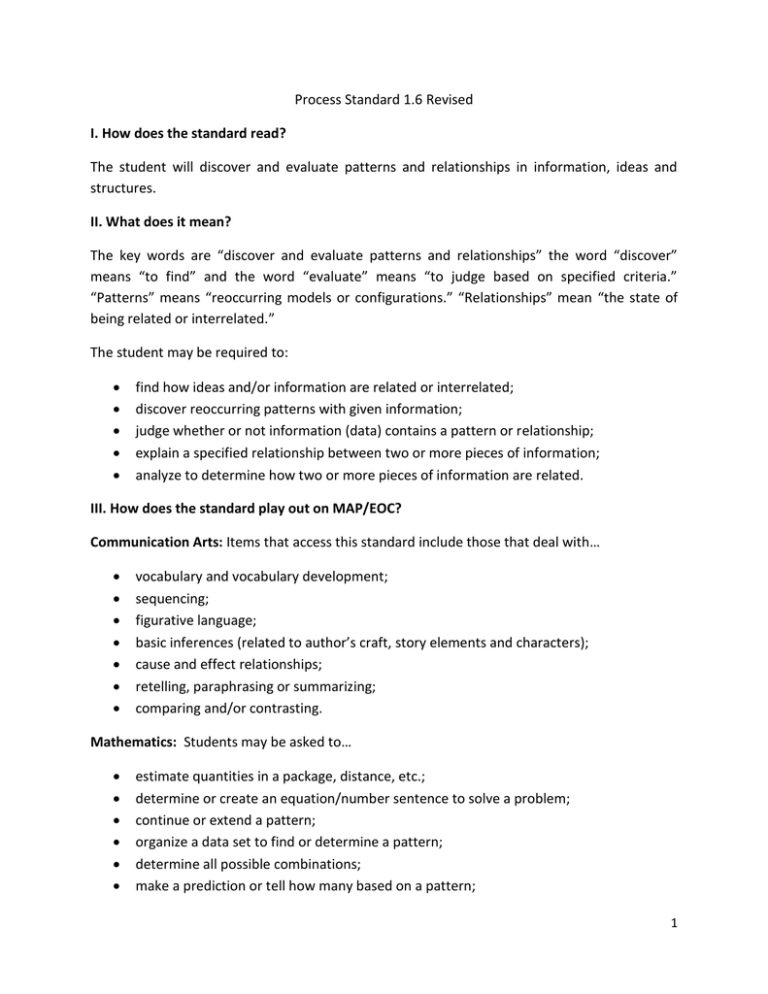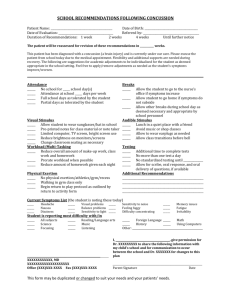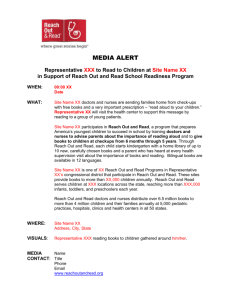Process Standard 1.6 Revised I. How does the standard read? The
advertisement

Process Standard 1.6 Revised I. How does the standard read? The student will discover and evaluate patterns and relationships in information, ideas and structures. II. What does it mean? The key words are “discover and evaluate patterns and relationships” the word “discover” means “to find” and the word “evaluate” means “to judge based on specified criteria.” “Patterns” means “reoccurring models or configurations.” “Relationships” mean “the state of being related or interrelated.” The student may be required to: find how ideas and/or information are related or interrelated; discover reoccurring patterns with given information; judge whether or not information (data) contains a pattern or relationship; explain a specified relationship between two or more pieces of information; analyze to determine how two or more pieces of information are related. III. How does the standard play out on MAP/EOC? Communication Arts: Items that access this standard include those that deal with… vocabulary and vocabulary development; sequencing; figurative language; basic inferences (related to author’s craft, story elements and characters); cause and effect relationships; retelling, paraphrasing or summarizing; comparing and/or contrasting. Mathematics: Students may be asked to… estimate quantities in a package, distance, etc.; determine or create an equation/number sentence to solve a problem; continue or extend a pattern; organize a data set to find or determine a pattern; determine all possible combinations; make a prediction or tell how many based on a pattern; 1 identify a pattern then extend it to arrive at an answer; relate basic numerical operations to one another; draw a representation of a mathematical concept; draw, describe or determine transformations; determine a rule to describe a relationship; state the rule a pattern is illustrating or exhibiting; determine or describe similarities and differences; compare or order numbers, shapes, etc.; use scale drawings to estimate distance; develop and analyze methods for solving proportions; explain mathematical relationships between numbers, data in a table, etc.; use spatial relationships to create a floor plan or design; relate basic number operations to each other; identify similarities and differences; classify based on characteristics or properties. Science: Students may be asked to… articulate the pattern; evaluate relationships among organisms, structures, or concepts by identifying similarities and differences; select/create a graphic (picture, chart, graph, data table, etc.) that best represents the pattern described in the prompt; explain smaller units go together to make a whole (cells to organisms, one step in a process, etc.); explain impact; place objects or events in sequential order (expressing a pattern or relationship); classify organisms or objects based on their properties; develop or explain an analogy to demonstrate understanding of a relationship. Social Studies: Students may be asked to… identify causes of a given event; identify likely consequences of an event or proposed action; determine, analyze, or explain cause/effect relationships; identify or explain concept-to-example relationships; classify examples under appropriate concepts/categories; determine or explain patterns from data, historical information or ideas; 2 make predictions based on patterns; explain geographic direction/distance relationships, (i.e. How is one place related to another based on location?); explain how one place is related to another in regard to distance, location, proximity, etc. IV. What do sample questions look like? Communication Arts: SEE Pages 6 to 9 Mathematics: SEE Pages 10 to 22 Science: SEE Pages 23 to 25 Social Studies: Students could be given… o statistical tables on immigration and asked to discover patterns emerging from the data; o a number line and asked whether it is plausible for one given event on the timeline to be called a cause of another event; o two or more primary sources that deal with the same event and asked to explain what we can learn from them about the event from those sources and to explain why those two sources may be in disagreement with each other; o statistical tables pertinent to immigration and asked to draw a conclusion from those tables, identifying patterns implicit in those tables; o two maps, one showing various physical features and the other showing population densities, and asked to explain what conclusions they can draw about human settlements based on their study of both maps. Students could be asked to… o interpret information presented in a Venn diagram; o explain how two historical events, documents, decisions, figures, etc. are alike and different; o place events, historical figures, documents, decisions, etc, in order based on time, impact, etc. Electives and Support Classes: Template Forms to Be Adapted Accordingly Tell three ways XXX and XXX are alike and three ways they are different. Put the XXX in order based on XXX (i.e. size, time, etc.) Explain the effect on XXX if XXX. Explain the relationship between XXX and XXX. Based on the information presented in the XXX (i.e. data, table, picture, etc,) determine a pattern. 3 Classify the XXX into categories/groups based on XXX. Put the XXX (i.e. objects, cards, paper strips, etc.) into two groups. Then give each group a title. Be ready to tell why you classified the XXX the way you did. Draw or create a model that represents XXX. Explain why your drawing/model represents XXX. V. What strategies and/or activities might be done to improve achievement on the standard? The core subject area teachers should use the information from this training to… include items on classroom tests that assess process standard 1.6; teach and model for students how to use processes required by standard 1.6 (i.e. compare/contrast, classifying, retelling, etc.); monitor student progress related to process standard 1.6; in groups and building-wide, analyze and use data related to standard 1.6. Teachers of electives or support classes should ask students to do 1.6 processes that are common across the cores areas….. find how ideas and/or information are related or interrelated; discover reoccurring patterns with given information; judge whether or not information (data) contains a pattern or relationship; explain a specified relationship between two or more pieces of information; analyze to determine how two or more pieces of information are related; classify; make basic inferences (read between the lines); compare and contrast; determine and explain cause/effect relationships; make and justify predictions based on patterns and relationships; make representations of concepts; order objects, events, etc.; explain impact. 4 VI. What might be done to ensure ideas are implemented properly and with fidelity? Who? Will do what? By when? 5





